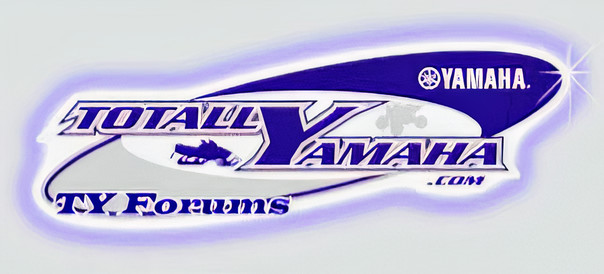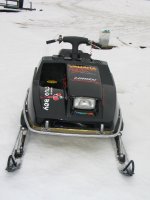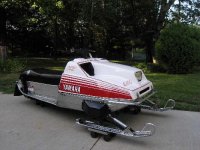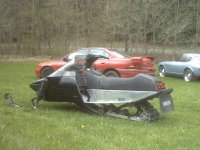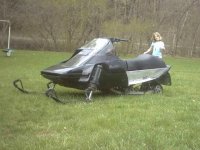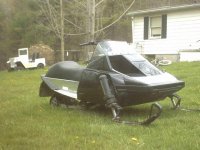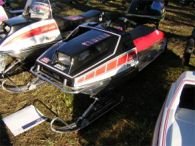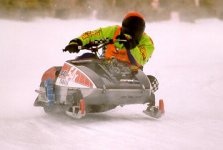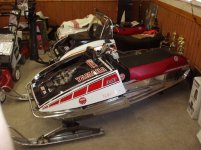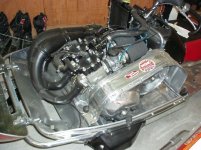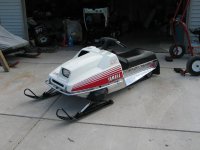TimeBomb
New member
any pics of under the hood on the 77 and 80?
YAMMIEGOD3:16
Active member
DUDE, WHATS THE CHASSIS NUMBER ON YOUR 78. IT SHOULD BE 8G9 !! 3:16 (tony)
YAMIE77
Member
SRX freek
New member
3:16 are you going to lakewood on sun.? i'll be bringing my 80 srx and aleast one 78 srx. hope to see you there! neat idea for a show , have a srx roundup!! Dennis
YAMMIEGOD3:16
Active member
FREAK, MARK AND I WILL BE THERE. NOT BRINGING MY 80 SRX THOUGH, THATS RETIRED UNTIL THE ELKLAND PA SHOW. BRINGING MY 1979 SRX. ERIC, YOUR WELCOME TO COME WITH US. !! 3:16 (tony)
RJH
New member
snopro
If you used the GP433 front suspension arm - you may have won. It plants the track much better. Try it... or mod yours.
If you used the GP433 front suspension arm - you may have won. It plants the track much better. Try it... or mod yours.

Snojet Steve
New member
Interesting.. Does this mod work for the older un-tapered tunnels (GPX) as well?
snopro
New member
RJH
the sled that took first place was another Yamaha SRX. it was a 77/78 snopro with a Wahl Bros rear skid and track.
i am happy with my rear skid. it does what i ask and is easily tunable
the sled that took first place was another Yamaha SRX. it was a 77/78 snopro with a Wahl Bros rear skid and track.
i am happy with my rear skid. it does what i ask and is easily tunable

SRXfromHELL
New member
YAMAHABUNCH
New member
RJH
New member
SnoJet Steve
Yes – It worked very well on the first 74 GPX. You will be astounded with the hole shot.
If you build a suspension dyno – so to speak – you would see that there is no weight on the front half of the skid under pressure. Yamaha built the consumer race sled to try and keep the skis down. Any drag on a Yamaha engine just kills it.
The extended shock arm gives it that needed leverage and simply plants the track. You will also need the rear GP 433 springs NEW. You can add some hockey stick struts to wind up the spring even more. There is one more thing at the rear scissor reversing a part gives about 1” of sag. Don’t worry about that yet. Do the above and you will be shocked it’s the same sled. (If it’s shifting right. 5000 engagement and I think max HP was 8250 RPM.
SnoPro
You may be happy and it looks great – but by the picture your skis are full lock and your still going straight.
If it was mine – which it is not – I would work on that.
I don’t recall any 77/78 Yamaha snopro sled. Maybe I forgot – very possible.
Yes – It worked very well on the first 74 GPX. You will be astounded with the hole shot.
If you build a suspension dyno – so to speak – you would see that there is no weight on the front half of the skid under pressure. Yamaha built the consumer race sled to try and keep the skis down. Any drag on a Yamaha engine just kills it.
The extended shock arm gives it that needed leverage and simply plants the track. You will also need the rear GP 433 springs NEW. You can add some hockey stick struts to wind up the spring even more. There is one more thing at the rear scissor reversing a part gives about 1” of sag. Don’t worry about that yet. Do the above and you will be shocked it’s the same sled. (If it’s shifting right. 5000 engagement and I think max HP was 8250 RPM.

SnoPro
You may be happy and it looks great – but by the picture your skis are full lock and your still going straight.
If it was mine – which it is not – I would work on that.
I don’t recall any 77/78 Yamaha snopro sled. Maybe I forgot – very possible.

snopro
New member
RJH.
thanks for the advice.
the skis in my pic are no longer on my sled. we are running the same ski now but cut alot shorter with a much lower/shorter leaf. it steers like it's on rails, just like it should
the 77/78 snopro that beat me at Eagle was owned by Dick Peterson. it was a 77 chassis with a 78 motor, mod pipes, 40mm carbs, Lee Frederickson repro snopro hood, Wahl rear skid and Wahl cleated track. the sled was originaly built by Troy Peterson. it flew! here is a pic of Dicks' sled..
thanks for the advice.
the skis in my pic are no longer on my sled. we are running the same ski now but cut alot shorter with a much lower/shorter leaf. it steers like it's on rails, just like it should

the 77/78 snopro that beat me at Eagle was owned by Dick Peterson. it was a 77 chassis with a 78 motor, mod pipes, 40mm carbs, Lee Frederickson repro snopro hood, Wahl rear skid and Wahl cleated track. the sled was originaly built by Troy Peterson. it flew! here is a pic of Dicks' sled..
Attachments
03viperguy
Moderator
nice pics! snopro, how is lee fredricksons stuff? heard he does twister belly pans
RJH
New member
Looks like you guys race on snow these days not shear ice as in the old days when it was colder – I guess.
You have some great looking replica stuff. The water cooled should be covered, for best tuning – but it looks much meaner hanging out.
The sled in my picture is a factory snopro sled. The shot is it winning at Peterborough in 1976 in 340cc. It entered that turn in the high 90 mph range. Look at the balance of the sled – like on a rail. Adema was on the US Yamaha team when he was killed the week before. Our team came home with the first ever Jim Adema Memorial Award.
Adema was on the US Yamaha team when he was killed the week before. Our team came home with the first ever Jim Adema Memorial Award.
It won by almost ½ lap, both days if front of all the other factories. The 440 that weekend was 2nd Saturday and hit by Yvonne D. on Monday while in 3rd. It was later sorted out with a softer clutch setup. The team was contracted to race in Canada only so missing Eagle River the week after was hard to take with the speed it had.
Both these sleds are someplace in Ontario.
If you’re interested the factory sleds .
The bolt holes were in the stock position and the chassis looked stock but it was about ½ the weight of the consumer model.
The track was made by Raider twin trackers in Michigan. It was a gates belt with a material called arboly bars. Weighed about 12 to 15 pounds and would spin almost full revolution by hand spinning. The drive was also a gates involute drive however it wasn’t lowered like the factory Polaris sleds. The lower chaincase was made bigger for accommodate a larger gear. The gears were 7075 T4 aluminum, double row.
The drive and jack shaft were steel but turned down very thin and gun drilled. The hood soooo good looking weighed nothing. The suspension was all aluminum thin thin thin. It was modified as I said before. The strap was there but just hung loose. The suspension balanced the sled. A twitch on the sled would bring it up on one ski going straight as it wanted to turn. I can’t remember the rear geometry –but it was unique. It carried the skis the full straight. It was unique as you didn’t have to lift off going into a turn to get the skis down – a shift it weight and little fear would do it.
The engine sat a little higher in the chassis than stock with shims. This was done to allow correct weight transfer. The ski saddles were kind of fake to give it a wide look. The caster was slightly upright from stock, not noticable. Again – engineered so the transfer was hitting the right carbide which was about 7” long. Note the picture how it steers at speed. The clutching had a lot to do with how it handled as well. It was always – right there! When you have to lean on a spring chassis – you are steering with the inside ski.
Both clutches were Cat – that’s before the press ever thought to look under the hood.
The engine had the stock crankcase and crank. The ignition was off a road race bike. The rods were polished. The pins were all thin wall. The pistons were very light one ring. The jugs were hand cast at the factory in Japan about $25,000 each. The porting was almost identical to the GYT barrels but water cooled. The ports were straight but not polished the exhaust was a mirror. The pipes weighed nothing the frequency was tested in the factory piano sound room. They were so thin you could bend them with your hand if you wanted. Race fuel was not used. One set or two of new Circle M carbs were used every race weekend. The tach would RIP to 8750 (I think that was the #) bounce then slowly climb. Just the blip of the throttle did this. It was never on the dyno on this side. No need – who cared – it was fast the way it was. No engine work was done.
The sled could almost be picked up by the handlebars. The sled in 76 got to race a third time against a few other factories. The fastest competition was Jacques V. on the 75 independent Skirule. The late Gilles was already in Formula Atlantic cars with Ecuri Canada. The Yamaha spring setup actually out handled the independent. His ignition quit ending his race one lap early. By reading what Jacques has made – they still haven’t figured it out – how to balance the suspension. Having looked at Dave W. clutching – he got that figured out. His statement once – we will always be in the first turn first several years ago tells me he understands that part well.
For a test, a solid piece of Titanium rod 1” in D. was made in a 90 degree to support the ski. In one lap the Ti. bent and stayed bent holding the ski under. That’s 1” material. So stupid back then – with shear ice – why were front springs even used. A fellow could have just made it solid. Then you would have to lean to keep it down.
You have some great looking replica stuff. The water cooled should be covered, for best tuning – but it looks much meaner hanging out.
The sled in my picture is a factory snopro sled. The shot is it winning at Peterborough in 1976 in 340cc. It entered that turn in the high 90 mph range. Look at the balance of the sled – like on a rail.
 Adema was on the US Yamaha team when he was killed the week before. Our team came home with the first ever Jim Adema Memorial Award.
Adema was on the US Yamaha team when he was killed the week before. Our team came home with the first ever Jim Adema Memorial Award. It won by almost ½ lap, both days if front of all the other factories. The 440 that weekend was 2nd Saturday and hit by Yvonne D. on Monday while in 3rd. It was later sorted out with a softer clutch setup. The team was contracted to race in Canada only so missing Eagle River the week after was hard to take with the speed it had.
Both these sleds are someplace in Ontario.
If you’re interested the factory sleds .

The bolt holes were in the stock position and the chassis looked stock but it was about ½ the weight of the consumer model.
The track was made by Raider twin trackers in Michigan. It was a gates belt with a material called arboly bars. Weighed about 12 to 15 pounds and would spin almost full revolution by hand spinning. The drive was also a gates involute drive however it wasn’t lowered like the factory Polaris sleds. The lower chaincase was made bigger for accommodate a larger gear. The gears were 7075 T4 aluminum, double row.
The drive and jack shaft were steel but turned down very thin and gun drilled. The hood soooo good looking weighed nothing. The suspension was all aluminum thin thin thin. It was modified as I said before. The strap was there but just hung loose. The suspension balanced the sled. A twitch on the sled would bring it up on one ski going straight as it wanted to turn. I can’t remember the rear geometry –but it was unique. It carried the skis the full straight. It was unique as you didn’t have to lift off going into a turn to get the skis down – a shift it weight and little fear would do it.
The engine sat a little higher in the chassis than stock with shims. This was done to allow correct weight transfer. The ski saddles were kind of fake to give it a wide look. The caster was slightly upright from stock, not noticable. Again – engineered so the transfer was hitting the right carbide which was about 7” long. Note the picture how it steers at speed. The clutching had a lot to do with how it handled as well. It was always – right there! When you have to lean on a spring chassis – you are steering with the inside ski.
Both clutches were Cat – that’s before the press ever thought to look under the hood.
The engine had the stock crankcase and crank. The ignition was off a road race bike. The rods were polished. The pins were all thin wall. The pistons were very light one ring. The jugs were hand cast at the factory in Japan about $25,000 each. The porting was almost identical to the GYT barrels but water cooled. The ports were straight but not polished the exhaust was a mirror. The pipes weighed nothing the frequency was tested in the factory piano sound room. They were so thin you could bend them with your hand if you wanted. Race fuel was not used. One set or two of new Circle M carbs were used every race weekend. The tach would RIP to 8750 (I think that was the #) bounce then slowly climb. Just the blip of the throttle did this. It was never on the dyno on this side. No need – who cared – it was fast the way it was. No engine work was done.
The sled could almost be picked up by the handlebars. The sled in 76 got to race a third time against a few other factories. The fastest competition was Jacques V. on the 75 independent Skirule. The late Gilles was already in Formula Atlantic cars with Ecuri Canada. The Yamaha spring setup actually out handled the independent. His ignition quit ending his race one lap early. By reading what Jacques has made – they still haven’t figured it out – how to balance the suspension. Having looked at Dave W. clutching – he got that figured out. His statement once – we will always be in the first turn first several years ago tells me he understands that part well.
For a test, a solid piece of Titanium rod 1” in D. was made in a 90 degree to support the ski. In one lap the Ti. bent and stayed bent holding the ski under. That’s 1” material. So stupid back then – with shear ice – why were front springs even used. A fellow could have just made it solid. Then you would have to lean to keep it down.

Last edited:
montynormand
Member
RJH
Interesting post... still haven’t figured out how to get my SR to turn!!!
Interesting post... still haven’t figured out how to get my SR to turn!!!
YamahaRacer
New member
- Joined
- Jan 11, 2006
- Messages
- 29
That 76 sno pro that dick race is reaaaallllyyy fasssttttT! I have rode it, you hit the gas and you better hang on like no tomorrow or it will rip you off!! RJH what year was that?
RJH
New member
The picture is from 1976. 
In the early 80’s, Yamaha had another factory sled based out west. It had independent front suspension but no where near Polaris or Doo technology.
We had a chance to test it. It was the SSR version I guess, can’t remember. The super mod 440 was absolutely insane. I never have driven a sled with such power out of a 440 then or since.
Mikuni had built some special carbs for it. They were 54 mm with a float bowl and butterfly valve.
You had to let off way to early to get the skis down to turn. Then…it still didn’t turn. I grabbed the belt after one race and I think I still have burn marks from it. Our set up belts ran just slightly warm. Think how fast it would have been properly clutched. Yamaha wouldn’t leave the sled here – they took it home.
We didn’t win on it. One run, the under the chassis steering arm broke making it really exciting coming out of a turn.
Montynormand
I guess because it was only ever raced on banked ovals. Just press the gas and hang on.
That Gene Glaze guy and Adema taught everyone to run the inside. Not as much fun to watch as some goof riding the rim of a 12’ snow bank.

In the early 80’s, Yamaha had another factory sled based out west. It had independent front suspension but no where near Polaris or Doo technology.
We had a chance to test it. It was the SSR version I guess, can’t remember. The super mod 440 was absolutely insane. I never have driven a sled with such power out of a 440 then or since.
Mikuni had built some special carbs for it. They were 54 mm with a float bowl and butterfly valve.
You had to let off way to early to get the skis down to turn. Then…it still didn’t turn. I grabbed the belt after one race and I think I still have burn marks from it. Our set up belts ran just slightly warm. Think how fast it would have been properly clutched. Yamaha wouldn’t leave the sled here – they took it home.

We didn’t win on it. One run, the under the chassis steering arm broke making it really exciting coming out of a turn.
Montynormand
I guess because it was only ever raced on banked ovals. Just press the gas and hang on.
That Gene Glaze guy and Adema taught everyone to run the inside. Not as much fun to watch as some goof riding the rim of a 12’ snow bank.
Last edited:
